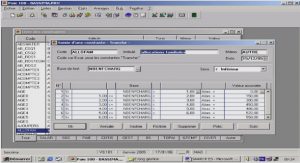Cours two Different SPSS Commands, tutoriel & guide de travaux pratiques en pdf.
SPSS Command: Transform – Recode – Into Different Variable
- Select POLVIEWS from variable list and add to window
- Under ‘Output Variable’ – ‘Name’ type a name for the new variable (Ex: RPOLVIEW)
- Select ‘Change’
- Select ‘Old and New Values’
- Under ‘Old Value’ select ‘Range’ – type 1 through 3
- Under ‘New Value’ select ‘Value’ – type 3 – select ‘Add’
- Under ‘Old Value’ select ‘Value’ – type 4
- Under ‘New Value’ select ‘Value’ – type 2 – select ‘Add’
- Under ‘Old Value’ select ‘Range’ – type 5 through 7
- Under ‘New Value’ select ‘Value’ – type 1 – select ‘Add’
- Under ‘Old Value’ select ‘All Other Values’
- Under ‘New Value” select ‘System Missing’ – select ‘Add’
- Select ‘Continue” – Select ‘OK’
To Create a Dummy Variable
Dummy variables are dichotomous variables in which a value of 1 is assigned to the group of interest and a value of 0 to everyone who is in the other category.
Ex: Create a Dummy Variable for SEX where
1 = Females
0 = Males
Two Different SPSS Commands
- Transform – Recode – Into Different Variable
This command will allow you to assign values of 0 and 1 to the appropriate response categories by indicating the “Old Value” and specifying the “New Value.” (The steps will be similar to the EDUC recode example).
- Transform – Count
- Under ‘Target Variable’ type the name of the new variable (Ex: FEMALES)
- Select the variable to change in the variable list and put it in the window by selecting the arrow (Ex: SEX)
- Select ‘Define Values’
- Under ‘Value’ select ‘Value’
- Type the value of the response category that you want to be valued as 1 in the dummy variable (Ex: 2 for Females). This tells SPSS to change the values 2 in SEX to values of 1 in the new variable FEMALES. All other values will be changed to 0.
- Select ‘Add’ – Select ‘Continue’ – Select ‘Ok’
To Reverse Code
Reverse coding refers to ‘flipping’ the category values (i.e. 1 becomes 8, 2 becomes 7,…,etc.). Reverse coding is often performed to simplify the interpretation of the relationship between to variables or to prepare variables to be combined into a scale.
Ex: Reverse code COHABOK to match coding of COHABBEF
Two Different SPSS Commands:
- Transform – Recode – Into Different Variable
Enter old value and replace it with new value. For example, for five response categories, old value 5 would become new value 1, old value 4 would become new value 2, and value 3 would be copied to remain the same.
- Transform – Compute
- Under ‘Target Variable’ type a name for the new variable (Ex: REVCHBOK)
- Determine the number of response categories in the variable and add one (Ex: 5+1 = 6)
- Under ‘Numeric Expression’ type 6 – select minus – select variable from list (COHABOK) and move it to the window
- Select ‘OK’
To Create a Scale
Social science research often uses scales as independent and dependent variables. Scales are comprised of 2 or more variables that measure similar constructs. When creating scales make sure variable coding are in the same direction (reverse coding may be necessary) and be sure to set desired responses to system missing.
Ex: Make a cohabitation attitude scale that includes COHABBEF and REVCHBOK.
SPSS Command: Transform – Compute
- Name the new variable (Ex: COHABSCL)
- Scroll in the functions list to find the MEAN function – Select it and add it to the window
- Select the variables that comprise the scale and add them to the window (one at a time) (Ex: REVCHBOK and COHABBEF)
- Move cursor to end of parentheses – select multiplication sign
- The expression is multiplied by the number of variables comprising the scale (Ex: 2)
- Select ‘OK’






